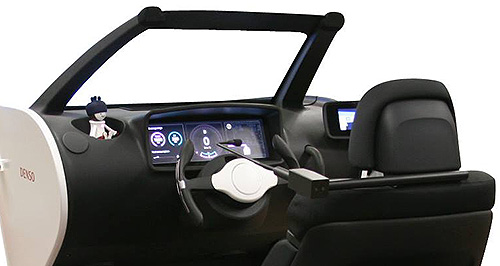Make / Model Search
News - General News - TechnologyMeet Hana, your friend in the driver’s seatI, robot: Hana is a concept that Denso says could grace future one-seat commuter vehicles, providing companionship as well as a second set of eyes on the road. One star at Tokyo motor show is a small robot that is always ready to help25 Nov 2013 By BARRY PARK in TOKYO A CROWD has gathered around one of the displays at this year’s Tokyo motor show, and for once, it’s not a car that’s drawing all the attention. Instead, a group of laughing Japanese businessmen is gathered as a smiling colleague makes his way along a virtual street in what global car components maker Denso says is a testbed for the dashboard of the future. What his colleagues are laughing at, though, is a small, 20cm tall doll with a flashing green light in the middle of her chest that has popped up slowly from the dash to greet him. “Konichiwa!” exclaims the high-pitched, childish Hana, as the world-first in-car communication robot is known, as her pencil-thin arms wave stiffly and she spins towards the driver. The cartoon-like Hana is more than just a dash-mounted trinket. From about 2020, says Denso, she will help to launch a new generation of interactive driver aids to create a human-machine interface that is more human than machine. The robotic doll could be just the solution that global car makers, rushing towards developing self-driving cars, are looking for in terms of how to bridge the divide between the real world and the virtual. One of the tasks that makers of autonomous cars are struggling with is finding a way that, if something goes wrong, they can hand control back to the driver in a way that won’t alarm them. It is a tricky task. Research by US car-making giant Ford several years ago found that if the dashboard sounds an alarm that sounds like an alarm, drivers are likely to panic in response. However, introduce a soft tone that has a degree of urgency to it – say a short, steeply rising note – and the driver is more likely to take notice and assess what is happening before reacting. Denso’s vision for what is likely to become the car interior of the future is more than just robots – it is also a guardian angel. As soon as the businessman jumped in behind the wheel of the mocked-up interior, the car was reading his heartbeat and temperature via touch-sensitive patches on the steering wheel. The procedure is all part of a pre-drive health check that also assesses what sort of medical state and mood the driver is in, even before a key is turned – or in the case of this virtual trip, a button is pressed. Almost as soon as the driver turns the first corner, the unusually chatty Hana – it is like having a five-year-old child in the seat beside you – shows her more grown-up side. As the Japanese businessman behind the wheel works his way down the virtual road, Hana swings around to look out the front of the car, and back to the driver once he is asked to merge into a lane currently occupied by another car. Her sensors scattered around the car have picked up the vehicle tucked in the driver’s blind spot, and Hana cautions him to wait for a gap, aiming her thin arm at the door-mounted LCD screen replacing the traditional wing mirror. The offending car is boxed inside a yellow square on the display, urging caution. As soon as the driver merges safely, again with a word or two of encouragement, Hana quickly rotates to resume her forward-looking vigil, chatting with the driver as he approaches an intersection. Once again, there is a lot of high-pitched chatter and arm waving as Hana points out crossing traffic to the driver. Denso says Hana is also designed to provide a level-headed companion in the cabin in an age where commuter-friendly, single-seat cars are expected to shrink around the driver. In that sense, Hana is as much a companion as a guardian angel. According to Denso spokesman Seiichiro Kunitomi, who is helping to introduce show-goers to Hana, the technology will need a lot more work before it becomes a commercial reality. “We need the infrastructure to communicate between vehicle to vehicle, and vehicle to infrastructure that we call VTX,” Mr Kunitomi says. “Hana is there to make drivers safer,” he says. The animated robotic doll is already such a celebrity that several big-name Japanese car brands are showing interest in how they can adapt her into their product line-ups. However, she is still a concept, and a long way off appearing on the dash of a car in whatever form you like – Mr Kunitomi says Denso’s plan is to have a range of different robots so owners can update to newer, and more fashionable, models. Once again, the Tokyo motor show has given a glimpse of where car makers expect to go, but while the cars themselves point to the future many of the interiors still look much like they do today. Vehicles such as the Toyota FV2 (the name stands for “Fun Vehicle 2”) may break convention, but instead of a charming robot, the three-wheeled pod that steers like a skateboard keeps a cold, clinical, computer screen-like interface between the driver and car. According to Mr Kunitomi, it will be the job of car-parts makers such as Denso to be the real innovators that break down the augmented reality walls. Waving her arms as yet another grinning businessman tackles the virtual streets and all their hazards, Hana couldn’t agree more.  |
Click to shareGeneral News articlesResearch General News Motor industry news |









Facebook Twitter Instagram